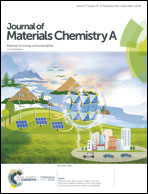Sulfonyl-based non-fullerene electron acceptor-assisted grain boundary passivation for efficient and stable perovskite solar cells†
Abstract
Passivating the grain boundary (GB) defects of polycrystalline perovskite films via fused-ring non-fullerene Lewis base deactivators is an effective approach to fabricate high-efficiency and high-stability perovskite solar cells (PSCs). We first introduced the sulfonyl group (O![[double bond, length as m-dash]](https://www.rsc.org/images/entities/char_e001.gif) S
S![[double bond, length as m-dash]](https://www.rsc.org/images/entities/char_e001.gif) O) to substitute the carbonyl group (C
O) to substitute the carbonyl group (C![[double bond, length as m-dash]](https://www.rsc.org/images/entities/char_e001.gif) O) group of fused-ring non-fullerene Lewis base deactivators. The novel acceptor material (IDIS-Th) possessing the sulfonyl group exhibited stronger interactions with the under-coordinated Pb ions or Pb clusters in a perovskite film compared with the contrast (IDIC-Th) to lower the trap density. Consequently, the IDIS-Th-containing PSC device achieved a higher-efficiency of over 20%, with a heightened VOC of 1.116 V, JSC of 22.67 mA cm−2 and FF of 79.1%. Moreover, the deactivators filling GBs could inhibit ion migration and resist moisture ingress, resulting in better environmental and thermal stabilities of PSC devices. Our results provide an alternative approach for designing and synthesizing better passivators to improve the performance of PSCs.
O) group of fused-ring non-fullerene Lewis base deactivators. The novel acceptor material (IDIS-Th) possessing the sulfonyl group exhibited stronger interactions with the under-coordinated Pb ions or Pb clusters in a perovskite film compared with the contrast (IDIC-Th) to lower the trap density. Consequently, the IDIS-Th-containing PSC device achieved a higher-efficiency of over 20%, with a heightened VOC of 1.116 V, JSC of 22.67 mA cm−2 and FF of 79.1%. Moreover, the deactivators filling GBs could inhibit ion migration and resist moisture ingress, resulting in better environmental and thermal stabilities of PSC devices. Our results provide an alternative approach for designing and synthesizing better passivators to improve the performance of PSCs.



 Please wait while we load your content...
Please wait while we load your content...